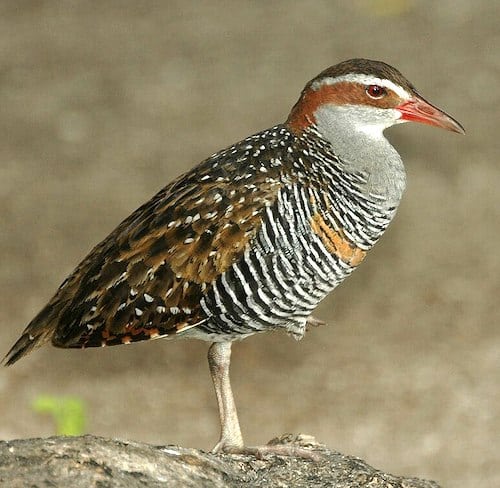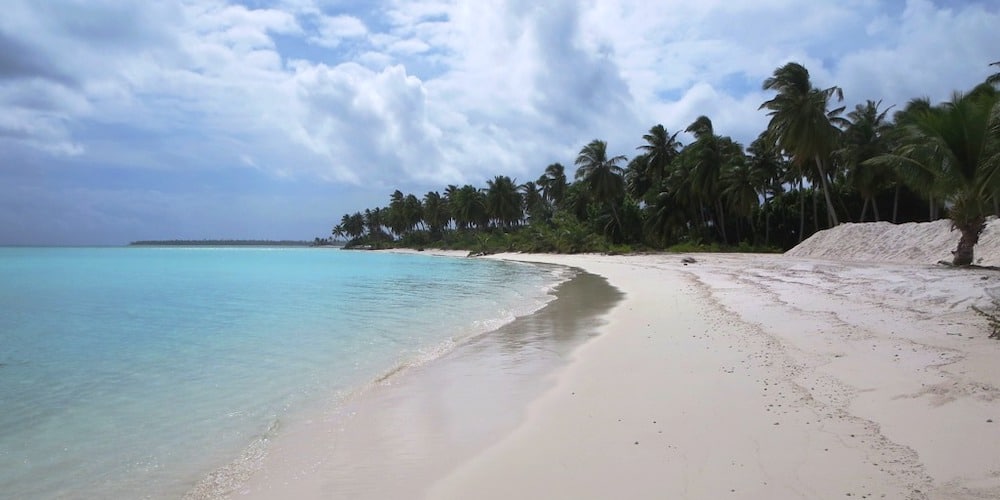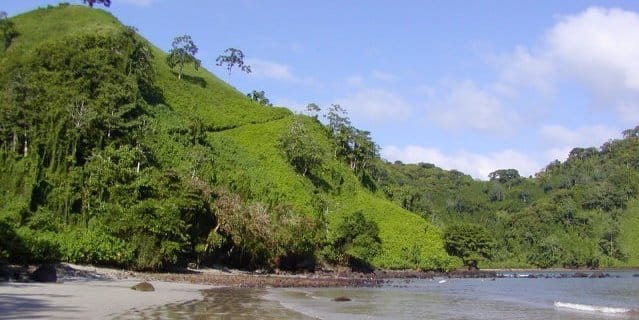Territory of the Cocos (Keeling) Islands

The Cocos (Keeling) Islands are an Australian external territory in the Indian Ocean, comprising a small archipelago approximately midway between Australia and Sri Lanka and relatively close to the Indonesian island of Sumatra. The archipelago lies approximately midway between the equator and the Tropic of Capricorn. The territory’s dual name (official since the islands’ incorporation into Australia in 1955) reflects that the islands have historically been known as either the Cocos Islands or the Keeling Islands.
The territory consists of two atolls made up of 27 coral islands, of which only two – West Island and Home Island – are inhabited. The population of around 600 people consists mainly of Cocos Malays, who mostly practise Sunni Islam and speak a dialect of Malay as their first language. The territory is administered by the Australian federal government’s Department of Infrastructure, Transport, Regional Development, Communications and the Arts as an Australian external territory and together with Christmas Island (which is about 960 kilometres (600 miles) to the east) forms the Australian Indian Ocean Territories administrative grouping. However, the islanders do have a degree of self-government through the local shire council. Many public services – including health, education, and policing – are provided by the state of Western Australia, and Western Australian law applies except where the federal government has determined otherwise. The territory also uses Western Australian postcodes.
The Cocos (Keeling) Islands consist of two flat, low-lying coral atolls with an area of 14.2 km2 (5.5 square miles), 26 kilometres (16 miles) of coastline, a highest elevation of five metres and thickly covered with coconut palms and other vegetation. The climate is pleasant, moderated by the southeast trade winds for about nine months of the year and with moderate rainfall. Tropical cyclones may occur in the early months of the year. The wettest month is April with precipitation totalling a little over 10 inches, and the driest month is October with precipitation of less than 4 inches. Due to the strong maritime control, temperatures vary little although its location is some distance from the Equator. The hottest month is March with an average high temperature of 30.0 °C, while the coolest month is September with an average low temperature of 24.2 °C.
North Keeling Island is an atoll consisting of just one C-shaped island, a nearly closed atoll ring with a small opening into the lagoon, about 50 metres wide, on the east side. The island measures 1.1 km2 (270 acres) in land area and is uninhabited. The lagoon is about 0.5 square kilometres (120 acres).

Home Island Beach, South Keeling – ©David Stanley CC BY 2.0 via Wikimedia Commons
Keeling Islands is an atoll consisting of 24 individual islets forming an incomplete atoll ring, with a total land area of 13.1 km2 (5.1 square miles). Only Home Island and West Island are populated. The Cocos Malays maintain weekend shacks, referred to as pondoks, on most of the larger islands.
There are no rivers or lakes on either atoll. Fresh water resources are limited to water lenses on the larger islands, underground accumulations of rainwater lying above the seawater. These lenses are accessed through shallow bores or wells.
Birding the Cocos Islands
The vascular plant flora of the Cocos (Keeling) Islands consists of approximately 61 species native to the 22 vegetated islands and about 69 introduced species, most of which are confined to the two larger inhabited islands, Home Island and West Island. There are no plant species endemic to the islands.
The terrestrial fauna of the Cocos (Keeling) Islands is unsurprisingly limited, because of the small land area of the islands, their lack of diverse habitats, and their isolation from large land-masses. However, the fauna dependent on marine resources is much richer.
North Keeling Island and the surrounding sea to 1.5 km from shore form the Pulu Keeling National Park. It is home to the only surviving population of the endemic, and endangered, Cocos Buff-banded Rail.

Pulu Keeling National Park – ©J RAWLS, CC BY 2.0 via Wikimedia Commons
As a small and isolated group of islands in two atolls 24 km apart in the eastern Indian Ocean, the number of species of resident landbirds (as opposed to seabirds and waders) is very small. These comprise the endemic subspecies of Buff-banded Rail, the introduced Green Junglefowl and Helmeted Guineafowl, White-breasted Waterhen, Eastern Reef Egret, Nankeen Night Heron and the introduced Christmas White-eye. Four other introduced species are now extinct in the Islands. Several other landbird species have been recorded occasionally, but none has established a breeding population.
Migratory waders recorded in the islands include some regular visitors as well as vagrants. None breeds there. However, North Keeling is important for breeding seabirds, with sizeable numbers of Red-footed Boobies, Great and Lesser Frigatebirds, Common Noddies and White Terns. Other breeding seabirds include Wedge-tailed Shearwaters, Masked Boobies, Brown Boobies, Red-tailed and White-tailed Tropicbirds, and Sooty Terns. It is possible that the Herald Petrel breeds there as well.
Presumably, before human occupation of the islands in the 19th century, seabirds bred on both atolls. However, with the establishment of a human population and the introduction of rodents to the southern atoll, significant seabird colonies are now restricted to the northern atoll of North Keeling. Although the Cocos islanders used to visit North Keeling regularly to harvest seabirds, this practice largely ceased with the establishment of Pulu Keeling National Park.
There are two new marine parks off Christmas Island and the Cocos (Keeling) Islands. The parks cover up to 744,000 km2 (290,000 square miles) of Australian waters. Both parks help to protect spawning of bluefin tuna from illegal international fishers, but local people are allowed to practise fishing sustainably inshore in order to source food.
-
Number of bird species: 169
(As at December 2024)
Number of endemics: 1 Sub-species
Cocos Buff-banded Rail Gallirallus philippensis andrewsi
-
Avibase
PDF ChecklistThis checklist includes all bird species found in Cocos (Keeling) Island , based on the best information available at this time. It is based on a wide variety of sources that I collated over many years. I am pleased to offer these checklists as a service to birdwatchers. If you find any error, please do not hesitate to report them. -
Indian Ocean Experiences
PDF Checklist -
eBird
PDF ChecklistThis checklist is generated with data from eBird (ebird.org), a global database of bird sightings from birders like you. If you enjoy this checklist, please consider contributing your sightings to eBird. It is 100% free to take part, and your observations will help support birders, researchers, and conservationists worldwide.
-
Pulu Cocos Museum
InformationThe museum includes displays on military and naval history, as well as local botanical and zoological items.
-
Cocos (Keeling) Islands Marine Park
WebpageSatellite ViewCocos (Keeling) Islands Marine Park covers an area of 467,054 square kilometres and extends from most of the islands’ shoreline to the limit of Australia’s Exclusive Economic Zone (AEEZ), approximately 200 nautical miles from shore.
-
Birding Tours Australia
Tour OperatorBirding Tours Australia are the experts when it comes to birds and Cocos knowing the locations of the key Cocos specialities such as Green Junglefowl, Western Reef Egret, White Breasted Waterhen, Saunders's Tern and having discovered more rare vagrant species on these islands than anyone else. A pristine lagoon encircled by tiny coral atolls, Richard Baxter of Birding Tours Australia has rediscovered this island paradise as a key location for encounters of rare vagrant species.
-
Birdwatching Cocos
ArticleThe Cocos Keeling Islands offer the avid birdwatcher the chance to combine sightings of 39 breeding or resident bird species with an iconic and remote tropical island experience. Unforgettable! The Cocos Keeling Islands intercept the southwest extremity of the East Asian - Australian flyway. Migratory shorebirds are the most travelled migrants, following the sun on their 25,000 km annual round trip from the Arctic Circle through South-East Asia and Australia to New Zealand. The non-breeding cycle, which takes place in the southern hemisphere, occurs from September to April. -
Christmas & Cocos Keeling Islands Birding Guide
PDF BrochurePDF Brochure - Your essential guide to birding on the islands. -
Fauna of the Cocos (Keeling) Islands
InformationAs a small and isolated group of islands in two atolls 24 km apart in the eastern Indian Ocean, the number of species of resident landbirds (as opposed to seabirds and waders) is very small. These comprise the endemic subspecies of buff-banded rail, the introduced green junglefowl and helmeted guineafowl, the white-breasted waterhen, eastern reef egret, nankeen night heron and the introduced Christmas white-eye. Four other introduced species are now extinct in the Islands. Several other landbird species have been recorded occasionally, but none has established a breeding population.
